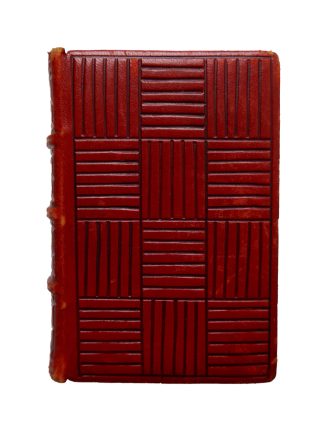PSALTER
Psalter in Latin, illuminated manuscript in Latin on vellum
Northern France/Flanders, (Picardy or Ghent?), last decades of 13th century£125,000.00
113 by 77mm, 228 leaves (plus one modern paper endleaf at front and back), wanting a gathering or so from beginning with Psalms 1-14 and perhaps also a Calendar, as well as first two leaves of current initial gathering (accordingly nineteenth-century pencil foliation commencing at ‘14’, and that used here), else complete, collation: i6 (wanting first 2 leaves), ii-xix10, xx-xxiii8, xxiv10, single column, 18 lines in a fine squat early gothic bookhand, a cacophony of line-fillers forming geometric shapes formed of red and blue penwork, small flower heads, golden fish and golden dragons with long trailing tails, small initials in blue with red penwork or liquid gold with blue penwork, the penwork often tracing long curling lines into upright margins and simplified foliage in lower margins, larger initials in liquid gold on dull-pink and blue grounds with angular gold edges, one large initial ‘C’ (opening “Confitebor tibi domine …”, the opening of Psalm 111, here fol. 200r) in blue with scalloping white penwork on pink and gold grounds, enclosing tightly curled swirls of foliage, and a noblewoman in white headdress on its top edge, kneeling as a bishop blesses her (most probably an ownership portrait, see below), nine historiated initials in blue or pink on gold and coloured grounds, many tags added to outer upright edges of leaves to aid finding parts of text, the last five historiated initials with a missing word or two following the initial where the scribe assumed the initial painter would add these but did not, in all but one place (fol.109v) these supplied by a contemporary hand in blue ink, two leaves with blank margins trimmed at base, some slight worming to last leaf, small spots and stains, else good condition, art deco red leather over pasteboards tooled with lined squares, traces of medieval fore-edge painting to resemble gauffering.
Text and Illumination:
The volume comprises Psalms 15-150, followed by the Magnificat, a Litany and other prayers. The initials here compare well with the refined works of this region in the last decades of the thirteenth century (such as the Psalter for the use of Ghent, mid-thirteenth century, now Getty MS. 14; 85.MK.239, and the Bestiary from Flanders, c. 1270, now Getty, MS. Ludwig XV 3;83.MR.173: see Kren, Illuminated Manuscripts from Belgium and the Netherlands, pp. 40 and 44-6; and the Bute Psalter, made north east France c. 1270, now Getty MS. 46;92.MK.92: see same series for French manuscripts, pp. 31-32), and sets it well above the more commonly found rustic examples. The historiated initials contain: 1. fol. 30v, David as a crowned king with a long staff, touching his eyes as God blesses him (opening “Dominus illuminatio mea …”, Psalm 26); 2. fol. 50r, God appearing from a cloud and blessing an enthroned David (opening “Dixi custodiam vias …”, Psalm 39); 3. fol. 67v, David brandishing a sword before a Jewish religious leader, probably representing Ahimelech to whom the text is addressed (opening “Quid gloriaris in …”, Psalm 51); 4. fol. 68v, King David standing before a fool representative of those “who work iniquity, who have devoured my people like a loaf of bread”, who holds a staff and bites from a circular piece of bread (opening “Dixit insipiens in …”, Psalm 52); 5. fol. 86v, Christ and David in different compartments of an initial, with Christ blessing while David is half-submurged in water (opening “Salvum me fac …”, Psalm 68); 6. fol. 109v, David with a stick ringing the bells hanging from a stone church (opening “E[xultate] deo nostro …”, Psalm 80); 7. Fol. 130r, three tonsured monks singing from a book on a lectern (opening “Cantate domino canticum …”, Psalm 97); 8. fol. 133r, David in prayer on the Mount of Olives (opening “Domine exaudi orationem …”, Psalm 101); 9. fol. 153v, the Crucifixion, with God the Father holding Christ on the Cross (opening “Dixit dominus …”, Psalm 109).
An elegant and high quality psalter – rare.
Provenance:1. Written and illuminated for the noblewoman in a white headdress and blue robes who is shown kneeling before a bishop on top of the initial on fol. 200r. She lived somewhere in the border region of north eastern France and adjacent Flanders: note SS. Bertin, Wulmar and Folquin in the Litany, whose cults can be located to St Omer, Picardy or Ghent, and the extreme north eastern tip of France, respectively.2. Carlo de Poortere (1917-2002), bibliophile and collector of fine bindings, who built a substantial collection of examples from the sixteenth century onwards with the aid of Brussels book-dealer Florent Tulkins: with his red leather label with gilt embossed binding-carriage on front endleaf.In stock












